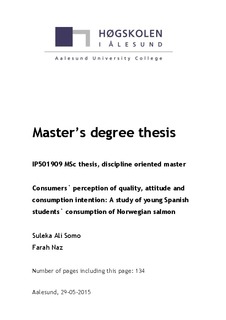| dc.description.abstract | Purpose – The main purpose of this study is to explore the consumption attitude of young Spanish consumers` towards eating Norwegian salmon. Another purpose is to find out the perception of the people regarding Norwegian salmon as a typical product of Norway. The role of country of origin and brand awareness on perceived quality was also taken into account.
Design/Method/Approach – Theory of reasoned action is used as a framework to explore the consumers` attitude and consumption intention towards Norwegian salmon. Attitude, subjective Norm in the traditional theory is extended with perceived quality, perceived benefits, perceived risks, perceived price, perceived inconvenience and trust in regulatory control in order to explain attitude, behavioral consumption intention and consumption frequency. The role or country of origin image and brand awareness in evaluation of perceived quality is also included in the extended model. The overall model is divided into four submodels. Four regression analyses are applied to get the results. The first regression of model 1 explored the effect of country of origin image and brand awareness on perceived quality. The second regression of model 2 explored the effect of perceived quality, perceived benefits, perceived price, perceived risks, perceived inconvenience and trust in regulatory control on attitude. The third regression of model 3 explored the effect of attitude, subjective norm and consumption frequency on behavioral consumption intention. And the fourth regression of model 4 showed the effect of behavioral consumption intention on consumption frequency. Data from survey of two hundred (200) students from university of Cantabria (Spain) was used.
Findings – The empirical findings shows that country of origin image and brand awareness has a significant positive association with perceived quality. In addition, perceived quality, perceived benefits, and trust in regulatory control have a significant positive effect on attitude. However, perceived inconvenience, perceived price and perceived risks have negative effect on attitude. The effect of perceived inconvenience is significant on attitude but perceived risks and perceived price showed an insignificant negative effect. Attitude, subjective norms and consumption frequency have a significant positive association with behavioral consumption intention. And the association between behavioral consumption intention and consumption frequency is also positive and significant. Hence, findings shows that the attitude of young Spanish consumers towards eating Norwegian salmon is positive and they also perceive ‘salmon’ as a typical product of Norway.
Limitation of the study- A major limitation of the study is that the results are not the representative for the whole Spanish population, because of the sample size and its socio-demographic characteristics. Because of their age and the fact that the majority lives at home with their parents gives different results regarding perceived price and perceived inconvenience than perhaps consumers with other ages and lifestyles. Living in the coastal areas does not represent the attitude and consumption intention of consumers living further form the coastline. Secondly, the study involved in the exploration of consumption attitude only towards the fish species of salmon.
3
Managerial Implications- it is advised to the Norwegian seafood council (NSC) to advertise more towards the younger segment regarding country image, nutrition value cooking recipes of Norwegian salmon, emphasizing its health benefits and convenience. The public health authorities and the producers should focus on convincing consumers that salmon not just provide benefits towards health but also convince them why the fish is good and what other tangible benefits they can get from eating of Norwegian salmon other than the nutrition and omega 3 such as pleasure and joy. This can be done through marketing communications. | nb_NO |

